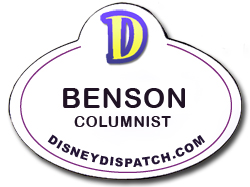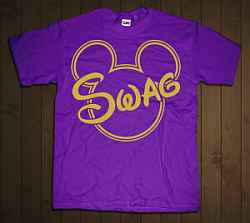FROM: It's All in a Nametag Published Thursdays
What Disney Wrought
When you think Atari, do you think Disney? Or Apple - Disney? How about Chuck E. Cheese? There's a reason why Chuck E. the rat resembles Mickey the Mouse, and Benson Myers has the goods as he traces the trace of Disney in so many, many things.
Do you believe in fate? That mystical, unseen force that some people believe guides us through life?
Well, if you do, sit right back and I will spin you a yarn of such things.
The story I offer is a tale of fate, destiny, luck, failure, and some unbelievable coincidences. It's the kind of story that makes for a good movie or a really bad romance novel. But it's also complicated, and goes in circles and ties itself into knots in places.
Are you sitting comfortably? Yes? All right, I will begin.
Nolan Bushnell
Once upon a time, there was a boy named Nolan Bushnell.
Nolan lived in a small town in Utah called Clearfield. Nolan was a bright boy, and played on the sophomore basketball team at his high school.
During high school, and later while pursuing an engineering degree at the University of Utah, Nolan managed midway carnival games at Lagoon, a local amusement park.
After graduating from college, Nolan moved from his home in Utah to the area of northern California that had become known as Silicon Valley. The area gained its name from the many computer and engineering firms headquartered there.
Nolan had at first wanted to work for the Disney Company. He was greatly impressed by the technological advances that WED Enterprises had made in the engineering and electronics fields, in particular its audio-animatronic figures.
Nolan said of Disneyland: "Although it's a place devoted to fun and frivolity it is really on the cutting edge of technology. People don't realize that frivolity is the gateway to the future, in that most future products don't start as necessities but as toys."
However, Disney was not interested in employing Nolan, and so he took a job at Ampex Corporation, where he continued to develop his keen interest in video games and electronics, and was highly influenced by a popular computer game of the time, Spacewar.
Noting the popularity of Spacewar with his friends at work, Nolan decided to start a business and sell video games to the public. His first game, Computer Space, was popular with his engineering friends, but failed miserably when he tried to sell it to bars and pool halls. It was just too complicated.
click an image to expand:
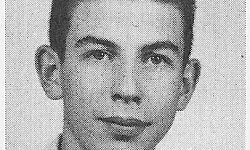
Nolan Bushnell's 1959 sophomore yearbook photo, Davis High School, Kaysville, Utah.
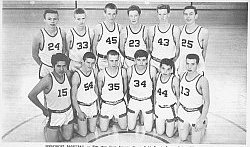
Nolan Bushnell on the 1959 sophomore basketball team at Davis High School, Kaysville, Utah.
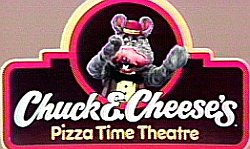
The original logo for Chuck E. Cheese.
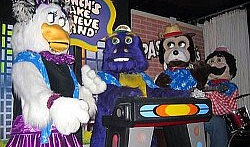
The animatronic figures developed for Chuck E. Cheese restaurants.
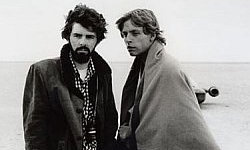
George Lucas and Mark Hamill on the set of Star Wars, 1977.
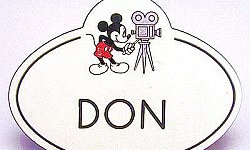
The nametag worn by cast members working at Theme Park Productions at WDI.
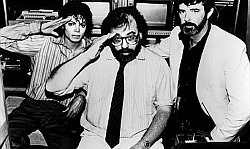
Michael Jackson, director Francis Ford Coppola, and George Lucas on the set of Captain EO.
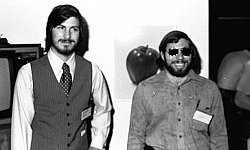
Steve Jobs and Steve Wozniak, the co-founders of Apple Computer.
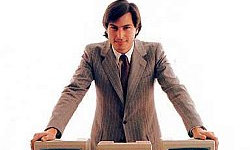
Steve Jobs and the Macintosh computer, in 1984.
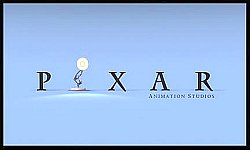
The famous Pixar Animation Studios logo.
So Nolan created a simpler game based on table tennis and called it PONG. It was a smash hit, and Nolan created a new company, Atari, to sell it and other video games.
I'm sure you've all heard of Atari and perhaps even played some of its console games. But Atari and video games aren't our focus today. In 1976, Nolan sold Atari to Warner Communications for $26 million. At this same time, he had created a concept for a business that drew upon his admiration for the animatronic figures at Disneyland: Chuck E. Cheese.
Known as 'Chuck E. Cheese's Pizza Time Theatre', the concept was a pizza restaurant that featured musical performances by an animatronic band, not unlike similar shows Nolan had seen many times at Disneyland. The restaurant was also filled with coin-operated video games and had a carnival midway atmosphere, things that Nolan knew well from his days at Lagoon Park back in Utah.
You might notice that Chuck E. Cheese bears a great similarity to Mickey Mouse. This was intentional, based on Nolan's love and admiration for Walt Disney.
In 1982, Nolan decided to expand the marketing for Chuck E. Cheese, and created a new subsidiary company called Kadabrascope Computer Animation Studios. Nolan hired animators and engineers from Disney and Hanna Barbera, and purchased a $1.5 million computer system to create a new animated television show featuring the Chuck E. Cheese characters. However, these plans did not come to fruition, and by 1984, the company was facing bankruptcy, and Nolan Bushnell was forced to resign as CEO.
The new president of Chuck E. Cheese decided that to save money, Kadabrascope would be shuttered or sold off. They shopped it around, and found a buyer in another Silicon Valley denizen. I'm sure you are familiar with him and his creations. His name is George Lucas.
George Lucas
George Lucas was born in Modesto, California, and from his earliest years found a fascination in films and how they were made. Lucas and a friend attended the opening day festivities of Disneyland on July 17, 1955. Lucas had been to many carnivals and amusement parks before, but he immediately knew that Disneyland was different. From that day on, he found great inspiration in the achievements of Walt Disney.
While attending film school at the University of Southern California, Lucas made an experimental film that was later remade as the feature THX 1138. In 1971, he founded the eponymous company, Lucasfilm, and soon became an industry leader in special effects for movies. In 1977, after having invented many innovative and revolutionary effects for creating special effects, Lucasfilm put them to use in Star Wars.
By the early 1980's, Lucasfilm and its subsidiary, Industrial Light and Magic, had begun to experiment with using computers to take some of the difficulty out of making special effects. Then, in 1984, Lucasfilm integrated the technology from recently acquired Kadabrascope, Nolan Bushnell's old company, into its computer graphics division, making it arguably the best in the world.
But, just to keep to the theme of this column, let's take a brief side trip.
In 1986, George Lucas's admiration for Walt Disney led to several new projects. Lucasfilm partnered with a new division of Walt Disney Imagineering, called Theme Park Productions, to create several new films for Disney attractions.
The two projects developed by Lucasfilm for Disney, Captain EO and Star Tours, were tremendous hits at Disneyland in California, and at the other Disney theme parks around the world.
Captain EO featured entertainer Michael Jackson and his rag-tag crew as they freed a planet through the power of music, and Star Tours was a high-speed motion simulator-based trip through the universe of Star Wars. Both films used the same motion-control special effects that Lucasfilm had developed ten years earlier.
Though only 17 minutes long, Captain EO became the most expensive motion picture ever made up to that time, at a cost of $1 million per minute.
Theme Park Productions produced other films for the Disney parks, such as Honey I Shrunk the Audience, Timekeeper, The Making of Me, Muppet-Vision 3D, and Cranium Command. In 1995, after the success of Captain EO and Star Tours, Lucasfilm again collaborated with Disney on The Indiana Jones Adventure at Disneyland.
But as we get back to our main tale, we find that fate is yet again fickle, taking us now to another Silicon Valley resident.
Let me set the stage.
In 1986, three years after the final Star Wars film, Return of the Jedi, Lucasfilm began to see a steep decline in revenue from its merchandise licensees. And George Lucas had just gone through a difficult divorce that left him strapped financially.
These factors, combined with the extreme financial failure of its latest movie, Howard the Duck, forced Lucasfilm cut back and sell off some of its assets.
So that brings us to the next person in our journey. To whom could George Lucas turn to save his company? None other than Steve Jobs, founder of Apple Computer.
Pay attention, dear readers; this is where things get a bit sticky.
Steve Jobs
Steve Jobs was born in San Francisco, in 1955, and like the other men we have met along our journey, found a strong connection to computers and electronics. During his high school years, he attended lectures at Hewlett-Packard. After graduating from high school, he was hired at Hewlett-Packard, where he met Steve Wozniak (about whom more soon).
Jobs enrolled at a college in Oregon, but dropped out after only one semester and returned to California. And this is where things get a bit weird. Jobs, along with Steve Wozniak, got a job in the engineering department at a company called Atari. That's right, the same Atari that our first hero, Nolan Bushnell, had founded.
Jobs and 'Woz' were assigned to finding a way to reduce manufacturing costs on an Atari game called Breakout. Woz found a solution to the problem, and it greatly impressed Jobs. While working at Atari, the duo had been attending meetings at a local amateur computer club, and Jobs convinced Woz that they could use their collective knowledge to design and build a personal computer they could sell to the general public.
So, in 1976, Apple Computer was born. The computers that Jobs and Woz built were different from others then on the market. They were affordable and user friendly, and sold in the millions. However, as with everyone we've talked about, fate got its fickle fingers in Steve Jobs's path. By 1983, the computers that Jobs and Woz had been selling were obsolete and falling behind the competition. Apple Computer needed new designs to stay afloat financially.
Jobs created the Macintosh computer, which featured a revolutionary 'point and click' interface. It differed from the text-only interface available in computers at the time. Problem was, while Jobs had great hope for it, the Macintosh was not initially a great success. Apple Computer had lost a lot of money when their first computers died out.
With the expensive failure of the Macintosh, Apple found itself in the same boat as Chuck E. Cheese and Lucasfilm. It was forced to make cutbacks, but Jobs would not agree to them. So, like Nolan Bushnell before him, Steve Jobs was forced out of his own company and resigned.
But again, thanks to our friend fate, this is where things get even weirder. After leaving Apple Computer, Steve Jobs sold all of his stock in the company for many millions of dollars. What do you think he did? First, he founded another computer company, NeXT, and then he bought the Graphics Group from Lucasfilm and rechristened it as an independent company called Pixar.
And here, once again, we're back to the Walt Disney Company.
Dating back to its origins as a division of Lucasfilm, Pixar had created and sold a high-end computer system called the Pixar Image Computer. It was marketed mainly to the U.S. government, medical industries, and other large companies. The Walt Disney Company was one of Pixar's first customers, and used the Pixar system to develop its CAPS system, which facilitates the process of moving hand-drawn animation onto film.
However, by 1990, due to their extremely high cost, sales of the Pixar computer systems were very poor. Pixar found itself sharing a very crowded boat with Chuck E. Cheese, Lucasfilm, and Apple Computer. Many employees were laid off, and the Pixar Image Computer was sold to another company.
Meanwhile, in an attempt to save what was left of the company, Pixar employee John Lassetter created a simple animation featuring a desk lamp called Luxo, Jr. to demonstrate Pixar's animation abilities to outside companies. Luxo Jr. was just the beginning, but it laid the future foundation of the company.
A short film called Tin Toy, directed by John Lasseter, won the 1988 Academy Award for Best Animated Short, and then in 1991, Pixar signed an agreement with The Walt Disney Company to produce three computer animated films.
One of them, Toy Story, grossed more than $350 million worldwide and saved Pixar from financial ruin. Pixar went on to produce many more computer-animated films, which won many awards worldwide, and grossed many billions of dollars in box office sales. But that's not the end of the story.
In 1997, Apple Computer was again in trouble, and its computers weren't selling very well. Apple's board of directors convinced Steve Jobs to return as CEO. He reinvented the company, and introduced products that saved Apple, including the iPod and the iMac. And, in 2006, The Walt Disney Company purchased Pixar from Steve Jobs in an all stock trade. The sale made Jobs the largest single Disney stockholder in the world.
The Wide Reach of Disney
So, dear readers, I hope you were able to follow the story from beginning to end. Did you see how the creative influence and legacy of Walt Disney was always present, no matter where we went in the story? Can you imagine that without Walt Disney, we would not have Chuck E. Cheese, Atari, Apple Computer, Pixar, the iPod, or Star Wars?
I will end my story here, and leave you to think about just how much Walt Disney and his influence have changed the world.
(Did I mention that I graduated from the same high school as Nolan Bushnell, only thirty years after him? Not that I am bragging or anything.)
More: IT'S ALL IN A NAMETAG
Stuff Not to Skip
- Nolan Bushnell [Wikipedia]
http://en.wikipedia.org/wiki/Nolan_Bushnell - George Lucas [Wikipedia]
http://en.wikipedia.org/wiki/George_lucas - Steve Jobs [Wikipedia]
http://en.wikipedia.org/wiki/Steve_jobs - Benson Myers's Blog
http://mousebadges.blogspot.com/2010/12/disney-store.html - Benson Myers's Nametag Museum
http://www.nametagmuseum.com




